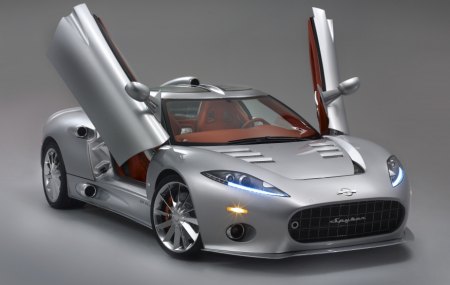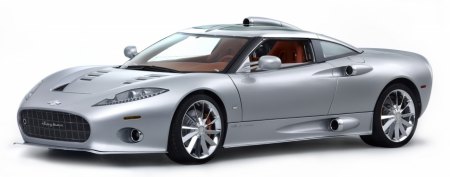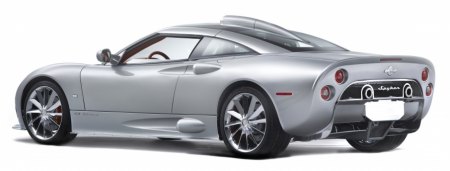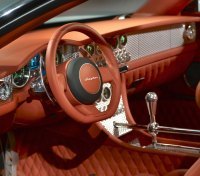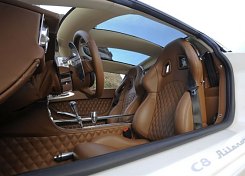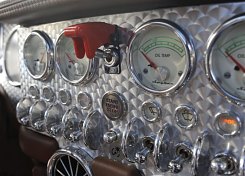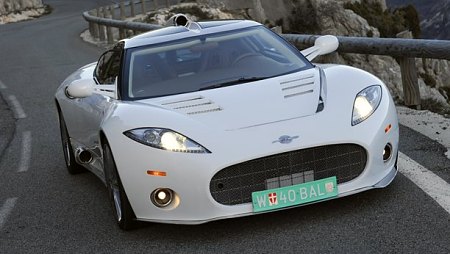Spyker C8 Aileron
Debut: 2010 |
||||||||||||
Victor Muller created Spyker because he was dissatisfied with the style and craftsmanship of Italian supercars. The original C8 did deliver what he promised - a classic-meet-modern exterior design and a million-dollar bespoke interior. However, Muller is no Enzo Ferrari or Ettore Bugatti. While he was good at art, he paid little attention to engineering or the dynamic aspect of his cars. This can be seen from the C8's temperamental handling, harsh ride and hefty controls. No wonder its sales failed to take off. 10 years on, Spyker is still building a few dozens cars a year from its Holland factory, and it has yet to turn a profit. Muller knows some big changes have to be made. On the one hand, Spyker has to slash a large part of its fixed costs in order to lower the breakeven point. On the other hand, it has to improve the engineering and dynamics of the C8. These requirements seem to be contradicting, don't they?
Don't worry, Muller is a smart guy (smart enough to swallow Saab). He made two important decisions to turnaround Spyker: 1) Asked Lotus Engineering to help developing the second generation C8. Lotus is an expert of handling and ride tuning, so with its help the dynamic aspect of C8 is guaranteed; 2) Outsource production of its chassis to British company Coventry Prototype Panels. CPP has been producing aluminum chassis parts for Bentley, Rolls-Royce and (soon) Aston Martin One-77, so it could build the aluminum spaceframe chassis of new C8 far more cost effectively than doing it inhouse. Moreover, it would save a lot of logistic costs as many component suppliers of Spyker are actually located in the UK. Called Aileron, the second generation C8 is again named with aviation in mind. This aviation image is further strengthened by 5 jet nozzle intakes, turbine-style alloy wheels and, of course, the Spyker badge. The styling is still recognizable as a C8, but compare with the outgoing car, it has evolved to be more streamline and more matured. The smoother body improves aerodynamics, especially downforce. The enlarged front radiator grille improves cooling. The LED-enhanced headlights are more modern. The cockpit is now a glass-roof greenhouse, stylishly split by the roof-mounted air intake. The new C8 shares only 20 percent parts with the old car.
What it didn't and needn't change much is the gorgeous interior, which is still the most flamboyant thing in the sports car industry. It has the craftsmanship of the luxury cars built in prior to the 1930s Great Depression. Every component is bespoke, made in either brushed / milled / machined aluminum, chromed stainless steel or stitched leather. There are countless of toggle switches and classical gauges taken straight from aviation industry. Complementing the antique environment is a new LCD information display located between the main dials. As before, the exposed gearshift rods give an extra sense of occasion, as are the butterfly doors (which open upward and forward). The only non-bespoke item is the Audi R8 steering wheel. Behind the latter is a pair of aluminum paddles for operating the ZF 6-speed automatic gearbox, which Spyker expect many customers will take instead of the Getrag 6-speed manual. The cockpit looks light and airy, thanks to the glass roof. Moreover, passenger space is much more generous than the first generation C8 due to its 150 mm longer wheelbase.
One of the reasons the old car handled so badly was its soft chassis. It was designed as an open car from the outset, so converting to coupe did not improve its chassis rigidity much. In contrast, the Aileron's aluminum spaceframe chassis is optimized for coupe. It also employs more cast nodes instead of rivets to bond the parts more rigidly together. As a result, its torsional rigidity has been increased by 2.5 times to 22,000 Nm/degree. Although this figure is not exactly outstanding by class standard – e.g. Porsche 997 is 33,000 Nm/degree, Cayman 31,500 Nm/degree, Ferrari F430 27,500 Nm/degree and Lotus Evora 26,000 Nm/degree – it hardly displays any body flex on the road. The extra 150 mm wheelbase and 155 mm front track also help taming its tricky handling at the limit. Lotus not only helped developing the chassis but also generously lent its forged aluminum double-wishbone suspensions of Evora to Spyker. In addition to larger AP brakes and 30mm wider rear tires, C8 Aileron has a much higher starting point than the old car. The only downside is weight, which gained 200 kilograms in the process. This make the carried-over Audi V8 engine less remarkable. The 4.2-liter unit is quite old. It comes from the old Audi S4 rather than R8 or RS5. It still employs the last generation 40-valve heads, intake-only variable valve timing and conventional port injection. With a rating of 400 horsepower and 354 lb-ft of torque, it looks impressive on paper. However, considering the old S4 produced only 344 hp and 302 lb-ft of torque, there is no reason a small tweak of intake and exhaust could generate another 56 hp and 52 lb-ft. As a result, Spyker's quote of 187 mph top speed and 0-62 mph in 4.5 seconds is very doubtful. To make its credibility worse, Spyker said the automatic transmission offers exactly the same performance as the manual gearbox. Can you believe ?
On the road, our doubt is proved correct. The C8 Aileron feels neither Ferrari-fast nor 400-horsepower-strong. Its performance falls in the territory of Audi R8, but that is the 8-cylinder R8 rather than the V10 version. For a supercar costing nearly £200,000, it is too slow. Not even its thundering exhaust noise could compensate for the unremarkable performance. The ZF automatic shifts smoothly, but its speed and shift pattern are too civilized for a sports car. Manual mode brings no improvement to response or involvement. Compare with powertrain, the chassis is more rewarding. The involvement of Lotus is evident from its absorbent ride, what a difference from the stiffly sprung old car ! The steering is pretty good, too, with quick and linear response, good feel and adequate assistance. Push the car over a series of mountain roads, it feels like a slightly larger and wilder Evora, inspiring confidence and encouraging you to push it harder. Its chassis balances well, rolls little and behaves much more friendly at the limit. Not so good is the braking, which works like an on-off switch. Another problem is the lack of traction control, stability control or any other electronic safety aids except ABS. For a car so expensive, it seems to be too raw. After all, Spyker is no Ferrari. If you compare it with Ferrari 458 square and fair, you will never choose the Spyker. It simply lacks the dynamic excellence and the versatile talent of the Ferrari, let alone a keener price and a more prestigious badge. Those very rare rich guys who would purchase the Spyker are likely to be attracted by its unique style and bespoke interior, or simply its exclusivity. You know, not many sports car specialists could produce so few cars, consistently making loss yet without going bankruptcy. You can't help amazing how Victor Muller managed that, at least until now. |
||||||||||||
| The above report was last updated on 28 Apr 2010. All Rights Reserved. |
| Specifications | ||||||||||||||||||||||||||||||||||||||||||||||||||||||||||||||||||||||||||||||||||||||||
|
||||||||||||||||||||||||||||||||||||||||||||||||||||||||||||||||||||||||||||||||||||||||
| Performance tested by: - |
Copyright©
1997-2010
by Mark Wan @ AutoZine
